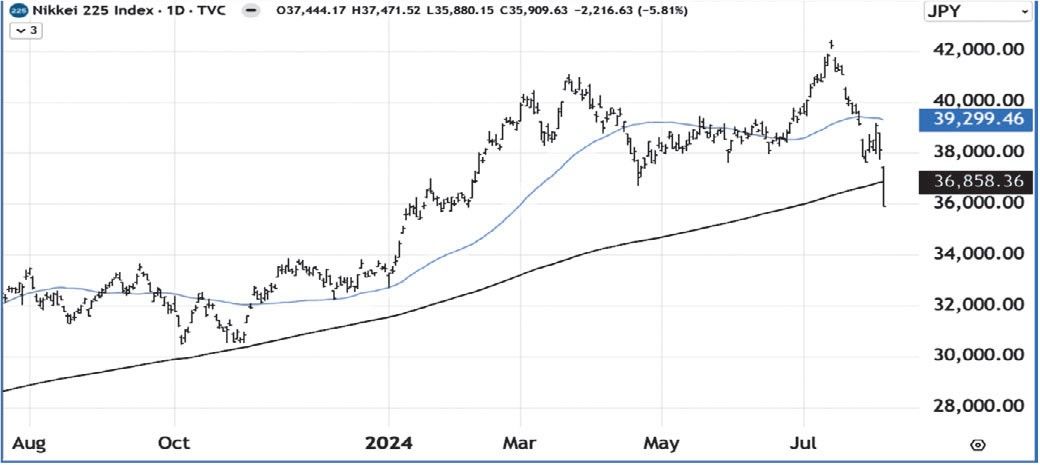First cut is the deepest

Financial markets remained volatile last week as the tech selloff spread to currencies, particularly the Japanese yen. Since July 11, the Nasdaq 100 has fallen 11 percent while the yen has appreciated by 10 percent against the dollar. These moves were triggered by a weaker-than-expected June US CPI report that fueled expectations of an imminent Federal Reserve rate cut.
As we wrote in a previous article, “Expectations of the Fed’s first cut are having the deepest, most significant effect on global capital markets. They are driving substantial moves in the US dollar and significantly impacting currencies, bonds and equity markets.” (see The cut is near, July 15).
Yen’s dramatic reversal
The yen’s surge has been especially dramatic. After plummeting to 38-year lows near 162 against the dollar in early July, the currency has rallied and closed at 146.47 last Friday. The chart below shows the USD/JPY pair reversing below previous breakout levels at 160 and 150. This rapid reversal reflects growing risk aversion in the markets and a potential unwinding of the crowded “long US dollar/short Japanese yen” trade.

BOJ’s currency intervention and policy shift
In early July, the Bank of Japan (BOJ) actively supported the yen through direct market intervention when it traded near the 160-level against the dollar. Official data published on Wednesday revealed that Japanese authorities spent 5.53 trillion yen (equivalent to $36.8 billion) during this period to bolster the currency. Furthermore, the BOJ raised its benchmark interest rate to around 0.25 percent on July 31, marking a significant shift from its historically dovish stance.”
Fed’s potential 50-bp cut
Meanwhile, expectations for the Fed’s next policy move have changed dramatically. After the soft US July payrolls number released last Friday, traders are now pricing in a 50 basis points cut in September, instead of the previously anticipated 25 bp. This combination of the BOJ’s rate hike and the possibility of an imminent, substantial Fed rate cut has further propelled yen’s rise.
Japan’s stock market collapses
Japan’s benchmark index nosedived on Friday due to recession worries. The Nikkei 225 tumbled by 5.81 percent to end at 35,909.63, marking its worst day since March 2020 and dropping below the 36,000-mark for the first time since January. Friday’s 2,216.63-point decline was the second largest in the index’s history, surpassed only by the Black Monday crash of October 1987. This brought the Nikkei below its long-term moving average (200-day), and down by nearly 15 percent from its all-time high registered on July 11.

Mighty tech has fallen
Exacerbating the global market instability, US stocks saw significant declines last Friday. The poor jobs data reinforced fears of a policy mistake by the Fed and that they are behind the curve. The Nasdaq Composite fell 2.4 percent on Friday, extending its decline from a recent all-time high to more than 10 percent - making it the first of the three major US benchmarks to enter correction territory. The ‘Magnificent Seven’ - a group of leading tech companies that have driven much of the market’s gains since 2023 - has fallen by 15 percent from recent highs. This downturn has spread to tech-heavy Asian markets, with Taiwan’s TWSE Index and South Korea’s KOSPI down 11 percent and eight percent, respectively, from their July highs.
Ghost Month jitters
Market jitters intensified with the onset of the Chinese ‘Ghost Month’ last August 4, a period traditionally associated with caution and is considered bad for stocks. As if on cue, yields on 10-year US Treasuries tumbled by the most since 2008 as investors scrambled for safe havens. Meanwhile, the VIX, also known as the investor ‘fear gauge,’ spiked to 29.66 last Friday before settling at 23.38 - far above its early July level of 12. This combination of the Ghost Month and August’s historical weakness for US stocks could potentially amplify investor concerns in the weeks ahead.
A challenging environment for investors
The confluence of factors driving market instability has created a challenging environment for investors. The yen’s dramatic reversal, coupled with the broader stock market selloff and growing recession fears, has amplified uncertainty. What started out as broadening that was welcomed by the market morphed into a fierce rotation and has now turned into a deep, painful correction. As central banks grapple with inflation and economic growth concerns, investors should brace for continued turbulence in the weeks ahead. Simultaneously, they must balance risk and opportunity in this volatile environment.
Philequity Management is the fund manager of the leading mutual funds in the Philippines. Visit www.philequity.net to learn more about Philequity’s managed funds or to view previous articles. For inquiries or to send feedback, please call (02) 8250-8700 or email ask@philequity.net.
- Latest
- Trending

























